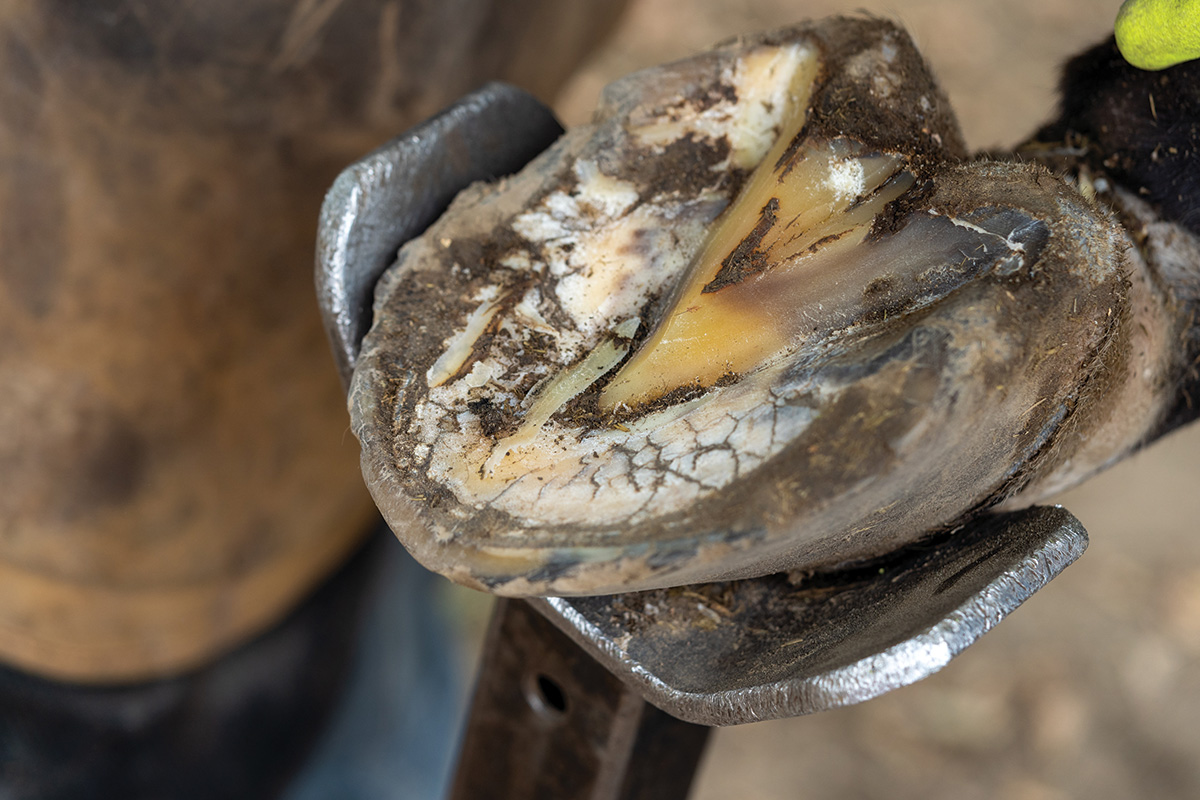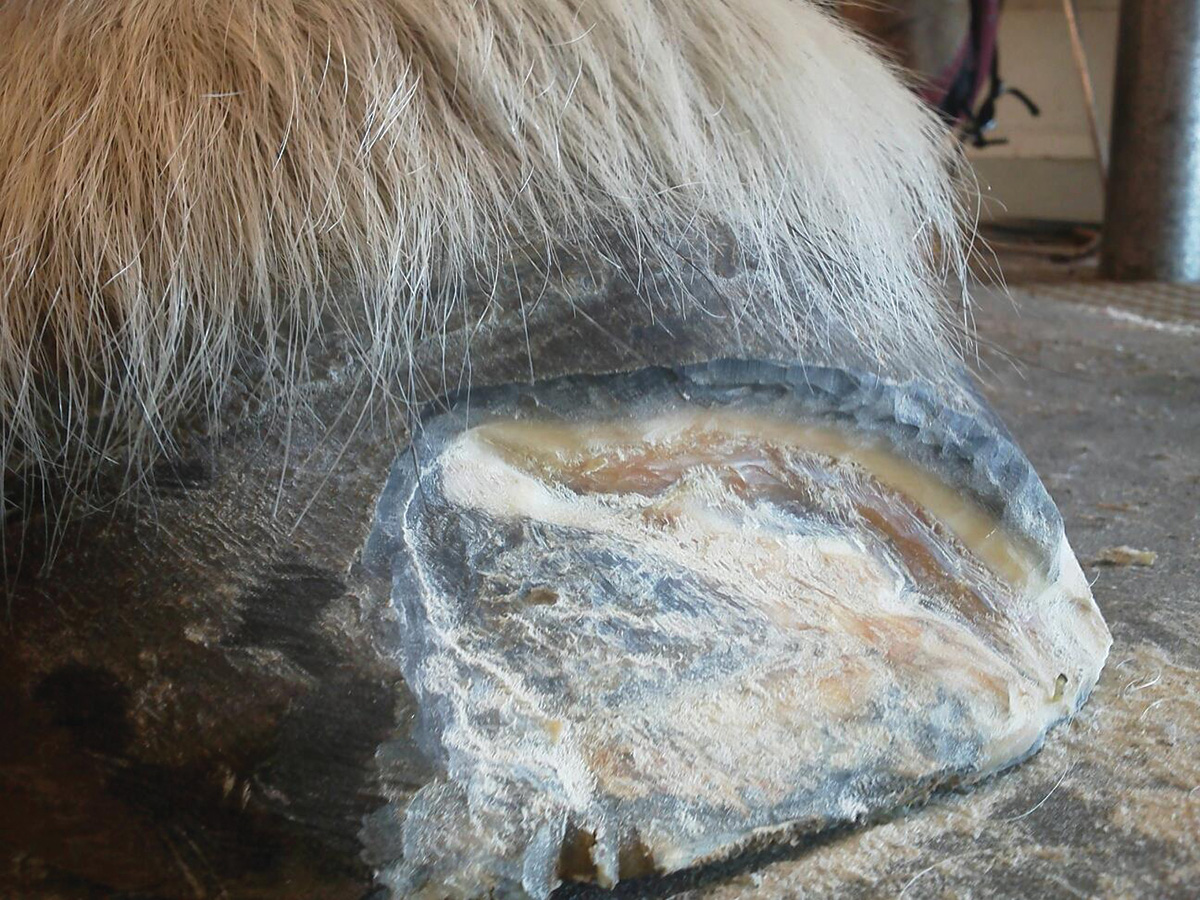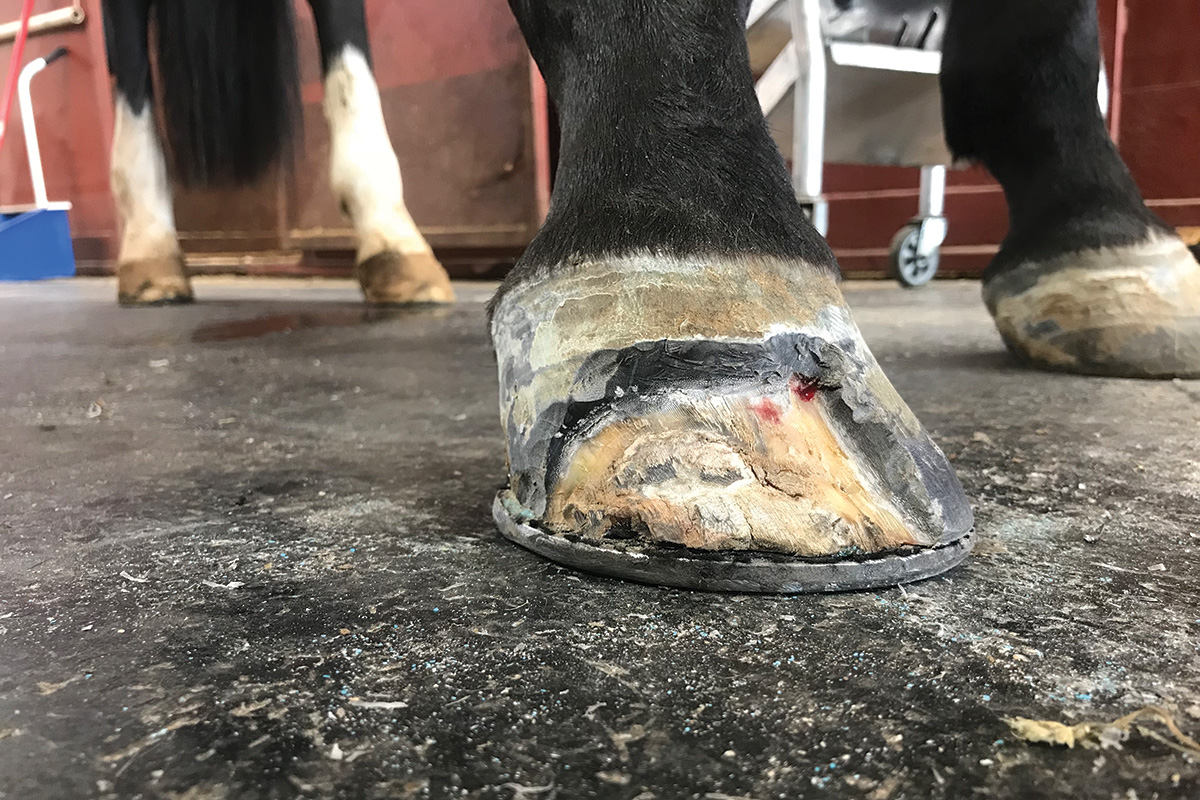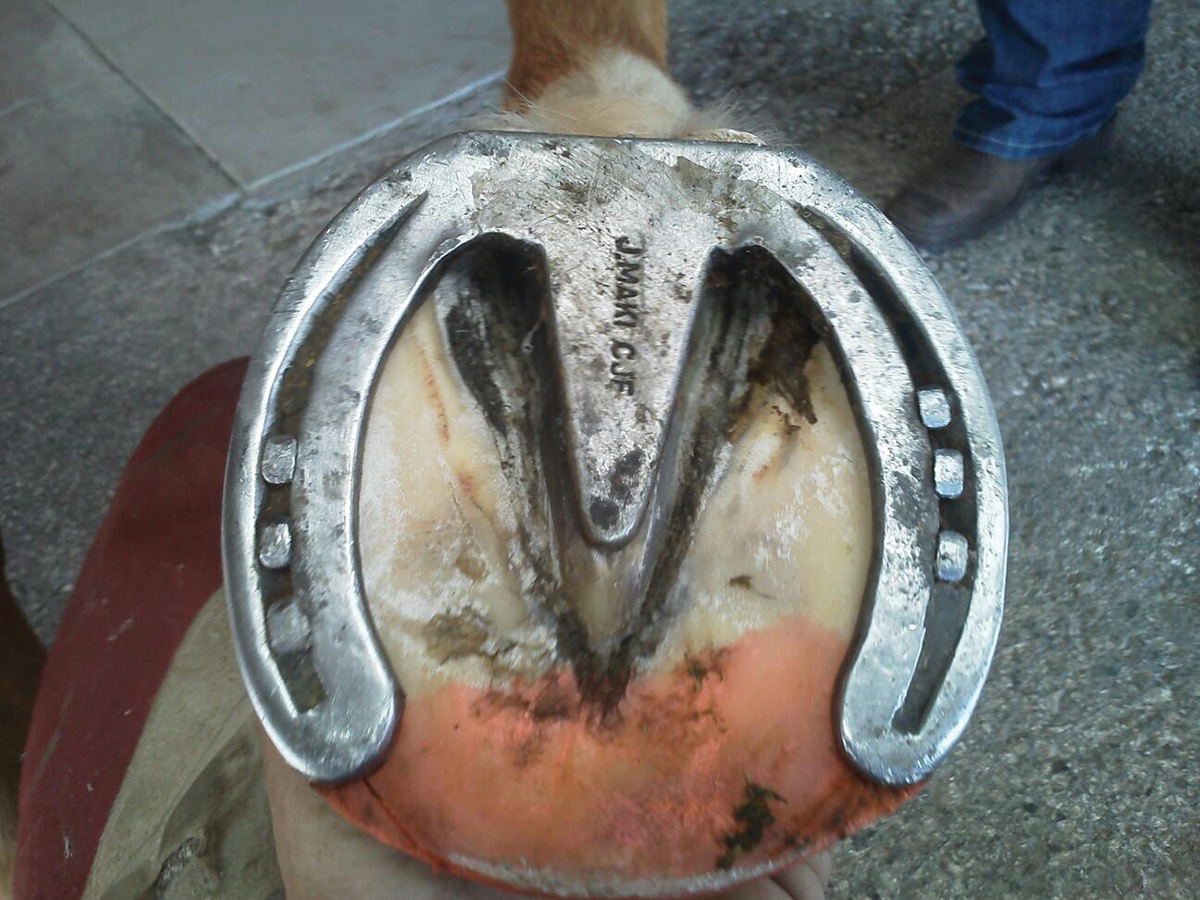Treatment is highly successful when this condition is caught in the early stages. Unfortunately, white line disease is often not detected promptly. This may lead to serious problems—sometimes even to the point of coffin bone rotation. However, most horses with white line disease aren’t lame unless the condition is allowed to progress to this stage.
The name “white line disease” is a bit misleading, since not all cases involve the actual white line of the hoof, which is where the sole joins the wall. When identified early and treated effectively, many cases are generally restricted to the “stratum medium”—the middle and thickest of the hoof’s three layers.

What is White Line Disease?
Technically, white line disease is not a disease, but rather a fungal infection of the equine hoof wall.
Infection develops when opportunistic fungi routinely present in the environment find an opening in the hoof wall. Once in the hoof, the fungi work their way up, digesting the keratin until a cavity is created beneath the wall.
Although the sensitive tissue of the hoof isn’t involved, the hoof wall separation caused by white line disease can have major consequences.
If left untreated, hoof integrity can be compromised to the point that the coffin bone pulls away from the hoof capsule and rotates. Although this is not exactly the same rotation that occurs with laminitis, it can still result in lameness.
Signs of White Line Disease
White line disease can affect horses of any breed, age, and discipline, infecting one or more feet at the same time. The following signs are associated with the condition and indicate a problem is brewing:
◆ Cracks or separation in the hoof at the toe, heel, along the wall or along the white line
◆ Debris packed deeply into the hoof wall
◆ Chalky, grayish-white powder visible between the hoof’s sole and wall
◆ “Rotten fruit” odor
◆ Significant flaring or dishing of the foot
◆ Hollow sound when outside of hoof is lightly tapped with a hammer
After operating his own farrier business for 11 years in Ohio, Jason Maki has been the full-time farrier at the Texas A&M College of Veterinary Medicine & Biomedical Sciences’ Large Animal Hospital in College Station, Texas, since 2008.
Maki points out the puzzling conundrum that horses receiving exceptional hoof care and living in well-managed barns can still get white line disease, as can backyard horses on inconsistent hoof care schedules.
“Sometimes a hoof that is dishing and flared is a sign of separation under the wall caused by white line disease,” says Maki.
He adds that hooves that become dished and flared because they’re allowed to get too long between trims may become more susceptible to this condition.
Maki agrees with the study published by Michael Wildenstein, Certified Journeyman Farrier, of Cornell University that identified fungal infection being to blame for white line disease. He notes that while specific fungi may be the primary cause of action, they can’t cause harm unless they get inside the foot.
“Essentially, there has to be a break or a micro crack in the hoof wall that allows the fungi to ‘set up shop,’” he explains. “The fungi are ingesting the hoof and create a pocket. The longer they’re present in the hoof, the more they will undermine it.”
The presence of grayish powder in any separation between sole and wall seems to be definitive of white line disease.
“The powder is disintegrating hoof wall,” says Maki, adding that if you see this when cleaning your horse’s hooves, you should contact your farrier promptly.
How to Treat White Line Disease
Wildenstein’s study revealed that the anerobic fungi responsible for white line disease can be effectively treated with a chlorine dioxide solution.
The basic protocol for treating white line disease is to debride the affected area, removing the damaged hoof wall to expose the infected portion of the hoof to air and then treating the area with chlorine dioxide. Because chlorine dioxide makes fungi and bacteria vulnerable to oxygen, this helps destroy them.

Maki points out that simply squirting a chlorine dioxide product up into the cavity isn’t enough. The infected portion of hoof wall must be removed.
“You follow the tract (cavity) as far as it extends and cut it out until the gray powder is not visible and you have good attachment to the hoof wall,” says Maki.
He is one of many farriers who have had great success treating the condition with a chlorine dioxide (ClO2) product. Maki personally swears by White Lightning equine hoof treatment.
“In my experience, debridement followed by White Lightning is the silver bullet for treating white line disease,” says Maki. “The chlorine dioxide gas infiltrates the hoof, gets into the nooks and crannies, and kills the fungi. If I even suspect white line disease, I use this to treat it.”
Challenges of Treatment
When caught early, your farrier can usually treat white line disease effectively at home. More complicated cases can require your veterinarian and farrier working together.
“Depending on how extensive white line disease is, or if the horse is lame, you’ll want to get your veterinarian involved,” says Maki. “White line disease shows up on a radiograph as bright white, so it gives you a good idea of the extent of erosion and also shows any rotation.”
When white line disease isn’t found and treated early, the farrier may have to cut away a significant portion of hoof wall to totally expose the affected area.

“You want to take only what you have to and leave enough wall to treat the hoof. If you have a deep white line tract but still have good attachment of the hoof wall, the hoof is less likely to splay,” says Maki, noting that the tricky part can be providing enough stability that the cure doesn’t become a problem.
Maki explains that if extensive sections of hoof wall have to be cut away, steps must be taken to stabilize the foot until new wall grows in. This may involve special shoeing techniques.
“You need to make sure the horse has good mechanical support of the hoof capsule,” he notes. “Managing extensive white line disease without a shoe or cast is problematic. I’ve found bar shoes, heart bar shoes, sole support, and clips to be useful for adding stability to the hoof and minimizing the chance of mechanical rotation due to instability.”

Environmental Considerations and Prevention
While the fungi to blame for white line disease are present in many environments, Maki has dealt with more cases when horses live in regions where the weather is warm and wet without extended periods of freezing temperatures.
While he says there’s no definitive answer as to whether some horses are simply more susceptible to white line disease, environmental conditions play a role.
Horses can’t be expected to have optimal hoof health if their feet are constantly exposed to moisture. When feet never get the chance to dry out, continuous moisture can compromise the hooves by softening and weakening them. This makes hooves more vulnerable to cracking and separation, which can allow in fungi and bacteria.
The goal is to keep hooves as dry as possible. This may mean waiting to turn out until the grass is dry and not turning out during wet weather.
Maki reminds horse owners that basic routine hoof care with short cycles between farrier visits is crucial for protecting horses against white line disease. He emphasizes that it’s always best to keep horses on a regular farrier schedule, even during times of the year when their hooves aren’t growing quickly.
Can Nutrition Help?Although supplements specifically targeted for hooves can’t be considered a preventative, Certified Journeyman Farrier Jason Maki thinks these may possibly lessen susceptibility to white line disease by making feet stronger. As he explains, when hooves have good horn quality, there is less breakdown in the connective layers, thus limiting the opportunities for opportunistic fungi and bacteria to invade the hooves. |
White Line Disease In Summary
White line disease poses a serious risk to horses, requiring vigilant monitoring and prompt treatment to prevent severe consequences. Though it can affect any horse, early detection and proper hoof care significantly enhance treatment success. By adhering to a proactive care routine and consulting with experienced farriers and veterinarians, horse owners can effectively safeguard their horses against this condition.
Further Reading on Hoof Health
◆ Helping Your Horse Have Healthy Hooves
◆ Nutrition for Hoof Health
◆ 5 Serious Hoof Conditions
◆ Keeping Your Horse Barefoot
This article appeared in the August 2023 issue of Horse Illustrated magazine. Click here to subscribe!





